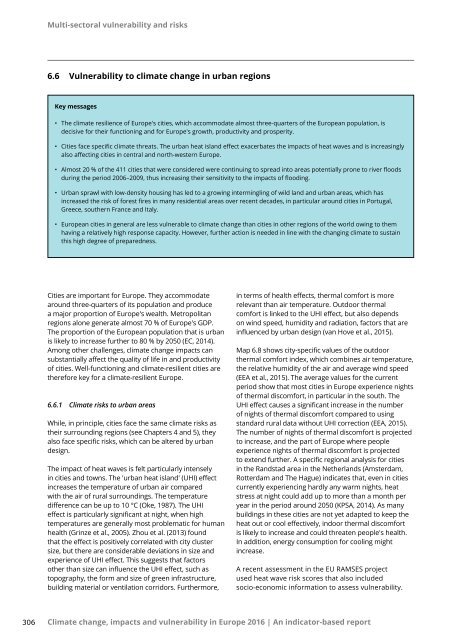Climate change impacts and vulnerability in Europe 2016
document
document
Create successful ePaper yourself
Turn your PDF publications into a flip-book with our unique Google optimized e-Paper software.
Multi-sectoral <strong>vulnerability</strong> <strong>and</strong> risks<br />
6.6 Vulnerability to climate <strong>change</strong> <strong>in</strong> urban regions<br />
Key messages<br />
• The climate resilience of <strong>Europe</strong>'s cities, which accommodate almost three-quarters of the <strong>Europe</strong>an population, is<br />
decisive for their function<strong>in</strong>g <strong>and</strong> for <strong>Europe</strong>'s growth, productivity <strong>and</strong> prosperity.<br />
• Cities face specific climate threats. The urban heat isl<strong>and</strong> effect exacerbates the <strong>impacts</strong> of heat waves <strong>and</strong> is <strong>in</strong>creas<strong>in</strong>gly<br />
also affect<strong>in</strong>g cities <strong>in</strong> central <strong>and</strong> north-western <strong>Europe</strong>.<br />
• Almost 20 % of the 411 cities that were considered were cont<strong>in</strong>u<strong>in</strong>g to spread <strong>in</strong>to areas potentially prone to river floods<br />
dur<strong>in</strong>g the period 2006–2009, thus <strong>in</strong>creas<strong>in</strong>g their sensitivity to the <strong>impacts</strong> of flood<strong>in</strong>g.<br />
• Urban sprawl with low-density hous<strong>in</strong>g has led to a grow<strong>in</strong>g <strong>in</strong>term<strong>in</strong>gl<strong>in</strong>g of wild l<strong>and</strong> <strong>and</strong> urban areas, which has<br />
<strong>in</strong>creased the risk of forest fires <strong>in</strong> many residential areas over recent decades, <strong>in</strong> particular around cities <strong>in</strong> Portugal,<br />
Greece, southern France <strong>and</strong> Italy.<br />
• <strong>Europe</strong>an cities <strong>in</strong> general are less vulnerable to climate <strong>change</strong> than cities <strong>in</strong> other regions of the world ow<strong>in</strong>g to them<br />
hav<strong>in</strong>g a relatively high response capacity. However, further action is needed <strong>in</strong> l<strong>in</strong>e with the chang<strong>in</strong>g climate to susta<strong>in</strong><br />
this high degree of preparedness.<br />
Cities are important for <strong>Europe</strong>. They accommodate<br />
around three-quarters of its population <strong>and</strong> produce<br />
a major proportion of <strong>Europe</strong>'s wealth. Metropolitan<br />
regions alone generate almost 70 % of <strong>Europe</strong>'s GDP.<br />
The proportion of the <strong>Europe</strong>an population that is urban<br />
is likely to <strong>in</strong>crease further to 80 % by 2050 (EC, 2014).<br />
Among other challenges, climate <strong>change</strong> <strong>impacts</strong> can<br />
substantially affect the quality of life <strong>in</strong> <strong>and</strong> productivity<br />
of cities. Well-function<strong>in</strong>g <strong>and</strong> climate-resilient cities are<br />
therefore key for a climate-resilient <strong>Europe</strong>.<br />
6.6.1 <strong>Climate</strong> risks to urban areas<br />
While, <strong>in</strong> pr<strong>in</strong>ciple, cities face the same climate risks as<br />
their surround<strong>in</strong>g regions (see Chapters 4 <strong>and</strong> 5), they<br />
also face specific risks, which can be altered by urban<br />
design.<br />
The impact of heat waves is felt particularly <strong>in</strong>tensely<br />
<strong>in</strong> cities <strong>and</strong> towns. The 'urban heat isl<strong>and</strong>' (UHI) effect<br />
<strong>in</strong>creases the temperature of urban air compared<br />
with the air of rural surround<strong>in</strong>gs. The temperature<br />
difference can be up to 10 °C (Oke, 1987). The UHI<br />
effect is particularly significant at night, when high<br />
temperatures are generally most problematic for human<br />
health (Gr<strong>in</strong>ze et al., 2005). Zhou et al. (2013) found<br />
that the effect is positively correlated with city cluster<br />
size, but there are considerable deviations <strong>in</strong> size <strong>and</strong><br />
experience of UHI effect. This suggests that factors<br />
other than size can <strong>in</strong>fluence the UHI effect, such as<br />
topography, the form <strong>and</strong> size of green <strong>in</strong>frastructure,<br />
build<strong>in</strong>g material or ventilation corridors. Furthermore,<br />
<strong>in</strong> terms of health effects, thermal comfort is more<br />
relevant than air temperature. Outdoor thermal<br />
comfort is l<strong>in</strong>ked to the UHI effect, but also depends<br />
on w<strong>in</strong>d speed, humidity <strong>and</strong> radiation, factors that are<br />
<strong>in</strong>fluenced by urban design (van Hove et al., 2015).<br />
Map 6.8 shows city-specific values of the outdoor<br />
thermal comfort <strong>in</strong>dex, which comb<strong>in</strong>es air temperature,<br />
the relative humidity of the air <strong>and</strong> average w<strong>in</strong>d speed<br />
(EEA et al., 2015). The average values for the current<br />
period show that most cities <strong>in</strong> <strong>Europe</strong> experience nights<br />
of thermal discomfort, <strong>in</strong> particular <strong>in</strong> the south. The<br />
UHI effect causes a significant <strong>in</strong>crease <strong>in</strong> the number<br />
of nights of thermal discomfort compared to us<strong>in</strong>g<br />
st<strong>and</strong>ard rural data without UHI correction (EEA, 2015).<br />
The number of nights of thermal discomfort is projected<br />
to <strong>in</strong>crease, <strong>and</strong> the part of <strong>Europe</strong> where people<br />
experience nights of thermal discomfort is projected<br />
to extend further. A specific regional analysis for cities<br />
<strong>in</strong> the R<strong>and</strong>stad area <strong>in</strong> the Netherl<strong>and</strong>s (Amsterdam,<br />
Rotterdam <strong>and</strong> The Hague) <strong>in</strong>dicates that, even <strong>in</strong> cities<br />
currently experienc<strong>in</strong>g hardly any warm nights, heat<br />
stress at night could add up to more than a month per<br />
year <strong>in</strong> the period around 2050 (KPSA, 2014). As many<br />
build<strong>in</strong>gs <strong>in</strong> these cities are not yet adapted to keep the<br />
heat out or cool effectively, <strong>in</strong>door thermal discomfort<br />
is likely to <strong>in</strong>crease <strong>and</strong> could threaten people's health.<br />
In addition, energy consumption for cool<strong>in</strong>g might<br />
<strong>in</strong>crease.<br />
A recent assessment <strong>in</strong> the EU RAMSES project<br />
used heat wave risk scores that also <strong>in</strong>cluded<br />
socio-economic <strong>in</strong>formation to assess <strong>vulnerability</strong>.<br />
306 <strong>Climate</strong> <strong>change</strong>, <strong>impacts</strong> <strong>and</strong> <strong>vulnerability</strong> <strong>in</strong> <strong>Europe</strong> <strong>2016</strong> | An <strong>in</strong>dicator-based report


